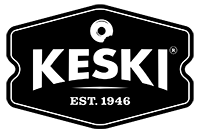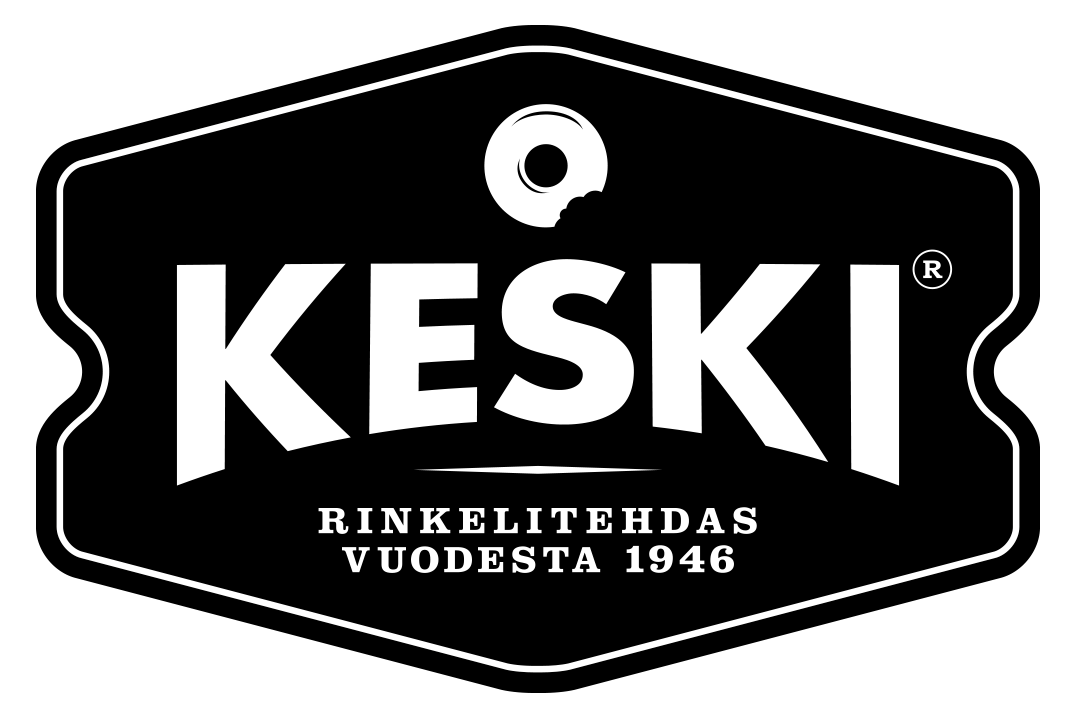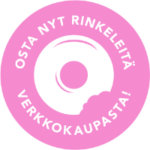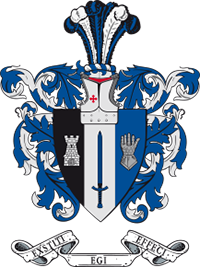SCROLL THROUGH THE YEARS AND DISCOVER THE COLOURFUL HISTORY OF THE FAMILY BUSINESS
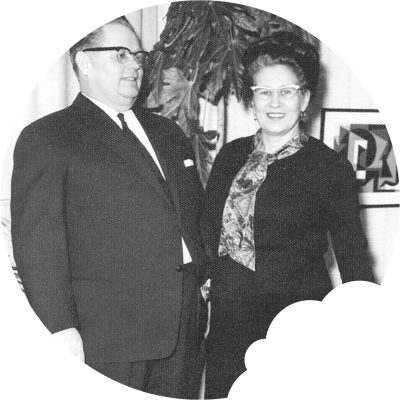
ON MAY 10TH 1946, AILI AND HANNES HAARA FOUNDED A COMPANY CALLED PIEKSÄMÄEN KESKI.
On May 10, 1946, Aili and Hannes Haara founded a company called
Pieksämäen Keski. During the depression, together with all its shortages, it was
the most challenging time to start a bakery and confectionery business. Both
raw ingredients and machinery were subject to rationing. But Aili and Hannes
were determined to succeed. They combined Aili’s (b. Niemi) South
Ostrobothnia's entrepreneurship and dedication, as well as the experience and
expertise acquired by Hannes from Nilsiä as an Osuuskauppa baker and pastry
chef. Aili Haara also had previous entrepreneurial experience — she had
already set up a lucrative bakery-cafe at Närpiö station at the age of 18. She
understood what it means to be an entrepreneur in Finland. In the beginning
everything had to be done in the bakery by hand, and sometimes work was
done around the clock.
1946
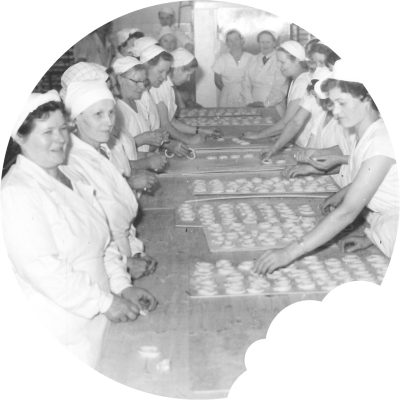
THE NAME KESKI ALSO HAS A VERY LOGICAL BIRTH HISTORY.
The name KESKI also has a very logical birth history. The bakery started its
activities concretely and proudly in the middle of the commercial sector, hence
the name KESKI.
1946
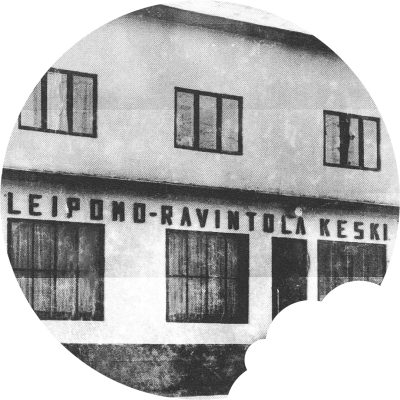
DESPITE THE DIFFICULT TIMES, THE ENTERPRENEURIAL ACTIVITIES BORE FRUIT.
Despite the difficult times, the entrepreneurial activities bore fruit. Already
after a couple of years of operation, Keski expanded its sales area to various
parts of Finland.
Due to the rapid increase in demand, large ovens were needed that could bake all kinds of bakery products from morning to night. The furnaces at the time were heated with wood. The large incinerators were located downstairs and had to be heated at night so that the baking could start early in the morning. The actual baking ovens were located on the next floor.
A 50-seat restaurant with food and alcohol serving rights was also opened in 1948. Keski was classed as a 1st class restaurant according to the system used at the time. A sign indicating this was proudly visible on the outside wall of the restaurant. During the autumn of the same year, a clothing store, a separate children's department and a department of mixed goods, milk, bread and meat were opened. Yet Keski's pride was always the high-quality confectionery department. It can be said that the Keski commercial building was a small department store at that time.
Due to the rapid increase in demand, large ovens were needed that could bake all kinds of bakery products from morning to night. The furnaces at the time were heated with wood. The large incinerators were located downstairs and had to be heated at night so that the baking could start early in the morning. The actual baking ovens were located on the next floor.
A 50-seat restaurant with food and alcohol serving rights was also opened in 1948. Keski was classed as a 1st class restaurant according to the system used at the time. A sign indicating this was proudly visible on the outside wall of the restaurant. During the autumn of the same year, a clothing store, a separate children's department and a department of mixed goods, milk, bread and meat were opened. Yet Keski's pride was always the high-quality confectionery department. It can be said that the Keski commercial building was a small department store at that time.
1948
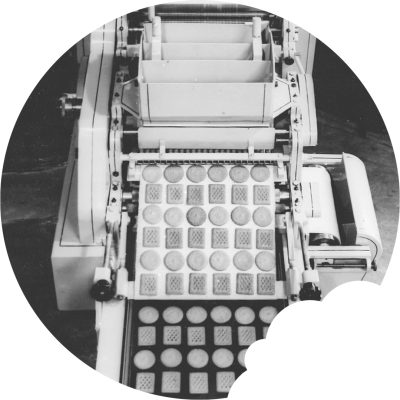
THE PRODUCTION OF CRACKER AND KRINGLE PRODUCTS BECAME MORE AND MORE EXTENSIVE.
The production of cracker and Kringle products became more and more
extensive. The bakery's machinery stock was renewed when, after three years
of waiting, an import licence was obtained to acquire a French bakery machine.
Due to rationing, bakeries only received permits to buy flour and syrup, so new
products had to be carefully planned. All this required great professionalism
and a lot of ingenuity.
The Finnish state also agreed to grant an import permit for the purchase of a modern Dutch biscuit machine. Its production capacity was up to 500 kg per hour! This is how Keski expanded its product range.
It was also the time of the Olympics buzz, when the most beautiful woman in the world came from Finland — and Coca-Cola came to Finland.
The Finnish state also agreed to grant an import permit for the purchase of a modern Dutch biscuit machine. Its production capacity was up to 500 kg per hour! This is how Keski expanded its product range.
It was also the time of the Olympics buzz, when the most beautiful woman in the world came from Finland — and Coca-Cola came to Finland.
1949-1952
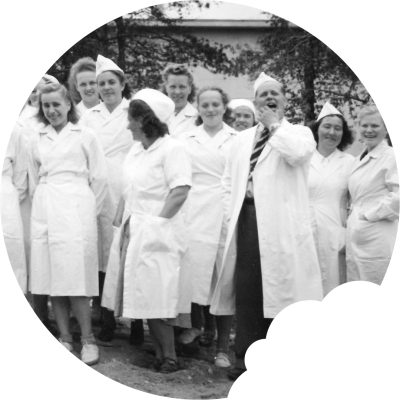
DURING THE BUSY WORKING HOURS, THE STAFF ALWAYS HAD TIME TO POSE TOGETHER.
During the busy working hours, the staff always had time to pose together. It’s
easy to smile, when the mind feels good and a growing company creates
security for the future.
1954
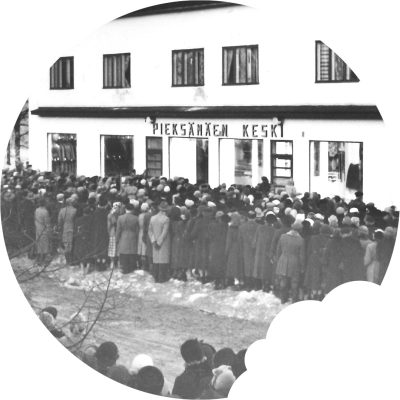
KESKI WAS VISIBLE AND HEARD IN THE STREET PICTURE OF PIEKSÄMÄKI.
Keski was visible and heard in the street image of Pieksämäki. Every year at
the beginning of October, the fashion shows starring Finland's most famous
mannequins gathered a crowd of people in front of Keski's shop windows.
In the showcase competitions organized by the Pieksämäki Entrepreneurs' Association, Keski enjoyed the popularity of the public and received the first prizes — several years in a row. The daughter of the family, Leena, contributed with special merit to the design and decoration of the victorious shop windows.
In the showcase competitions organized by the Pieksämäki Entrepreneurs' Association, Keski enjoyed the popularity of the public and received the first prizes — several years in a row. The daughter of the family, Leena, contributed with special merit to the design and decoration of the victorious shop windows.
1955

OPERATIONS CONTINUED TO EXPAND AS DEMAND FOR BAKERY PRODUCTS INCREASED.
Operations continued to expand as demand for bakery products increased.
More space was needed. Aili and Hannes Haara decided to implement an
additional building, for which they had received a building permit after some
challenging steps.
The manufacture of crackers and Kringles was moved to this additional building. A Werner & Pfleiderer dough machine and rotary kiln were acquired from Germany, of which only a few existed in Finland before Keski's investments. Two cracker-forming machines were also acquired from the Soviet Union at the same time, but they never worked. The baking of crackers continued to be done by hand.
The manufacture of crackers and Kringles was moved to this additional building. A Werner & Pfleiderer dough machine and rotary kiln were acquired from Germany, of which only a few existed in Finland before Keski's investments. Two cracker-forming machines were also acquired from the Soviet Union at the same time, but they never worked. The baking of crackers continued to be done by hand.
1957
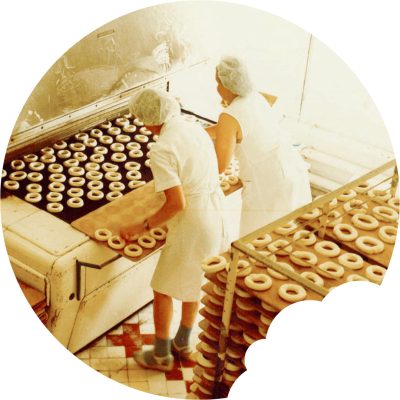
A NEW ROTARY KILN IN ACTION!
A new rotary kiln in action! The capacity of the factory was raised to a new
level. Keski was able to expand its sales and distribution area to cover the
whole of Finland. The first colour photograph taken at the factory also evokes
fascination.
1959
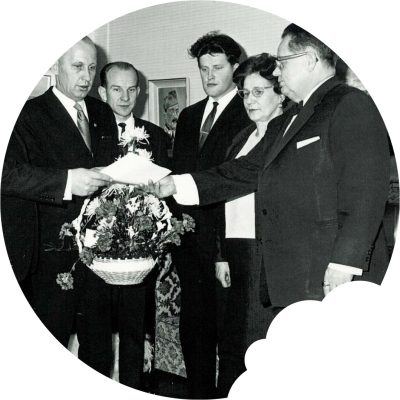
THE WORK DONE AT KESKI WAS ALSO NOTED AT A STATE LEVEL.
The work done at Keski was also noted at a state level. On 1st December 1967,
the President of the Republic Urho Kekkonen awarded CEO Hannes Haara the
honorary title of Talousneuvos for his contributions to the welfare and active
development of the province's economic life.
1967

ALTHOUGH DAUGHTERS LEENA AND KATARIINA WERE STILL PUPILS AND STUDENTS, THEY ARE ACTIVELY INVOLVED IN THE ACTIVITIES OF THE FAMILY BUSINESS.
Although daughters Leena and Katariina were still pupils and students, they are
actively involved in the activities of the family business — including the
creating ideas for new products. The photo is from the Frankfurt Bakery Fair.
1968

THE FAMOUS SUMMER OF FLOWERS.
The famous summer of flowers - the Summer of '69 - that is also referred to in
songs. During the summer season, more Kringles were exported around the
world in a day than there were hippies at Woodstock.
1969
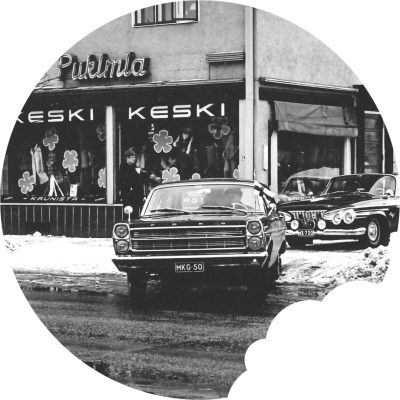
BLACK CARS TOOK OVER THE STREET VIEW OF PIEKSÄMÄKI.
Black cars took over the street view of Pieksämäki on the day of the funeral of
a prominent figure in March 1970. After the death of Hannes Haara,
responsibility for the company passed to Aili Haara. Over the years they had
together created a successful family business. Hard-working and diligent Aili
continued to lead and develop the company with determination.
1970

AILI AND HANNES HAARA'S GRANDSON SAMI HAARA CELEBRATES HIS 3RD BIRTHDAY WITH HIS MOTHER KATARINA AND FATHER FAROG.
Aili and Hannes Haara's grandson Sami Haara celebrates his 3rd birthday with
his mother Katarina and father Farog. At this point, Sami could hardly have
foreseen that he would one day be an entrepreneur and “Kringle Emperor”.
However, the servings were already fabulously delicious!
1979
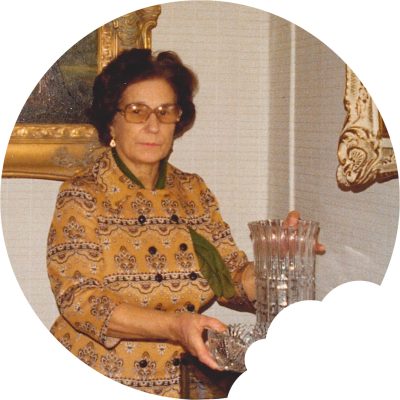
AILI HAARA WAS VERY PRO-REFORM IN EVERYTHING AND IN MANY RESPECTS AHEAD OF HER TIME.
Aili Haara was very pro-reform in everything and in many ways ahead of her
time. After one reform was done, she already began to plan the next one. For
example, she acquired three large automatic flour silos for the factory, which
significantly increased the efficiency of work in the bakery.
Keski’s delegation also visited Italy to get acquainted with their Kringle machines, their operation and the Kringle lifting lines. The machines were found to be highly functional, so it was decided to make a significant investment by acquiring an automated Kringle making line. Operational reliability, product quality and production capacity took a giant leap!
Keski’s delegation also visited Italy to get acquainted with their Kringle machines, their operation and the Kringle lifting lines. The machines were found to be highly functional, so it was decided to make a significant investment by acquiring an automated Kringle making line. Operational reliability, product quality and production capacity took a giant leap!
EARLY 1980s

AILI HAARA RECEIVED THE RECOGNITION SHE DESERVES.
Aili Haara received the recognition she deserved. She was awarded the
Pieksämäki Entrepreneur of the Year Award in 1986. In her thank-you speech,
Aili thanked the competent and loyal staff and particularly emphasised the
importance of product quality to Keski's 40-year success story.
And that's not all, there was more to come. Aili was also awarded Pieksämäki Resident of the Year in the same year — and she also received the prestigious Provincial Entrepreneur of the Year award.
And that's not all, there was more to come. Aili was also awarded Pieksämäki Resident of the Year in the same year — and she also received the prestigious Provincial Entrepreneur of the Year award.
1986
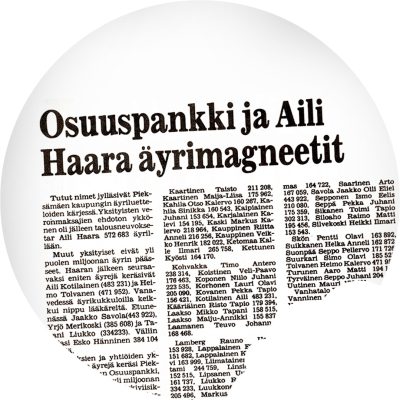
AILI WAS THE DETERMINED AND CHARISMATIC MATRIARCH OF THE HAARA FAMILY.
Aili was the determined and charismatic matriarch of the Haara family. A direct
and honest Ostrobothnian and self-respecting business manager and owner.
Therefore, as an accomplished businesswoman, she also amassed considerable
wealth.
1987–1990
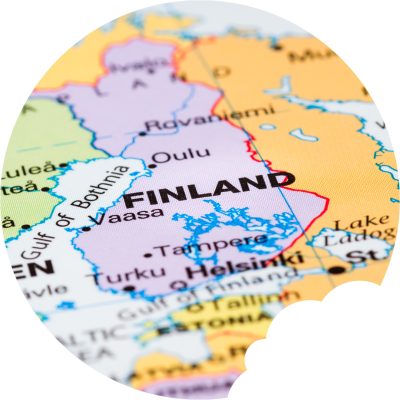
IT WAS DECIDED TO EXPERIMENT IF THE GRASS WOULD BE GREENER ON THE WEST SIDE OF THE BAY.
It was decided to experiment if the grass would be greener on the west side of
the bay. In other words, the sale of Kringles to Sweden, in the Gothenburg and
Stockholm regions, was started in 1991. In the following years, export efforts to
Russia also paid off, as Keski Kringles were included in the assortment of the St.
Petersburg Siwa chain.
1991
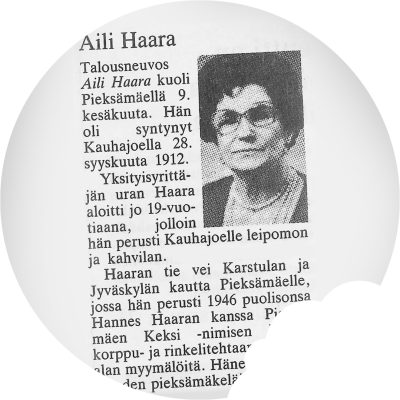
SAD NEWS.
Sad news. In June 1992, entrepreneur Aili Haara passed away after running the
company for more than two decades following Hannes' death. After Aili's death,
responsibility for the company passed to her children, Heikki and Katariina.
Leena had already established her own art design company in Helsinki.
1992
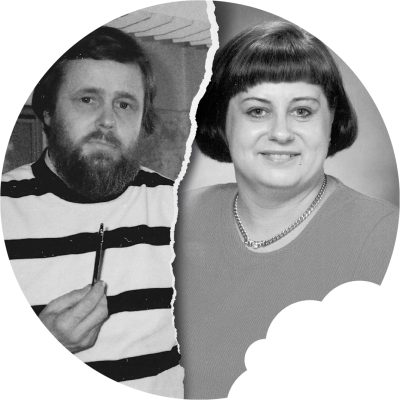
ENTREPRENEURSHIP SHOWS THE SIBLINGS IN THEIR FIRST YEARS ALL ITS MOST CHALLENGING ASPECTS.
Entrepreneurship shows the siblings in their first years all its most challenging
aspects. It was a time of recession, which was, however, overcome. After that,
Heikki and Katariina's major differences in views on the management and
development of the company came into the picture. They were reflected in the
company's turnover and earnings, which plummeted. Keski's economic
situation began to be worrying.
1993–1996
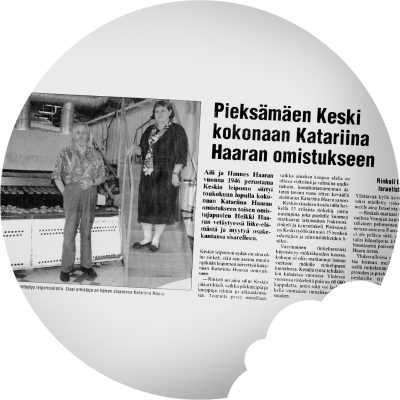
KATARIINA ENTERED INTO NEGOTIATIONS TO BUY THE SHARES OF THE ALMOST-BANKRUPT COMPANY FROM HER BROTHER HEIKKI.
Katariina began negotiations to buy the shares of the almost-bankrupt
company from her brother Heikki. A deal was reached in the end. As a result of
the transaction, Katariina was the sole owner of the entire company. At the
same time, she decided to give up on the clothing sales. Keski's activities again
focused on the manufacture of Kringles, their nationwide sales and marketing.
The business was made profitable, revenue increased and profit improved.
1997–1998

THE HAARA FAMILY AND KESKI FACE TRAGIC TIMES AGAIN.
The Haara family and Keski face tragic times again. Katariina's husband Farog
dies of a heart attack, and only four months later, Katariina herself passes
away exhausted by a severe illness. Responsibility for the company is passed
to their son, Sami Haara, aged just 23.
1999
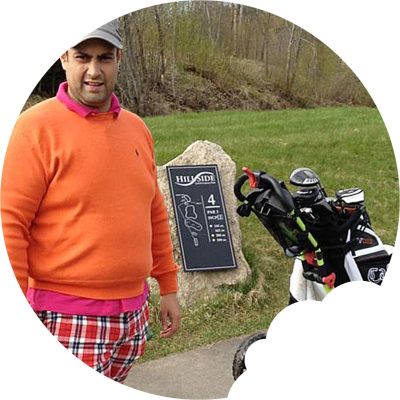
THE BEGINNING OF THE MILLENNIUM WAS A TIME OF LEARNING FOR THE YOUNG ENTREPRENEUR AND HIS COLOURFUL PERSONALITY.
The beginning of the millennium was a time of learning for the young
entrepreneur and his colourful personality. But Sami was quick-witted,
business-spirited and marketing-oriented. When he had a good idea, he worked
for it courageously and tirelessly. To the surprise of many, the business quickly
took off on a new upswing.
EARLY 2000s
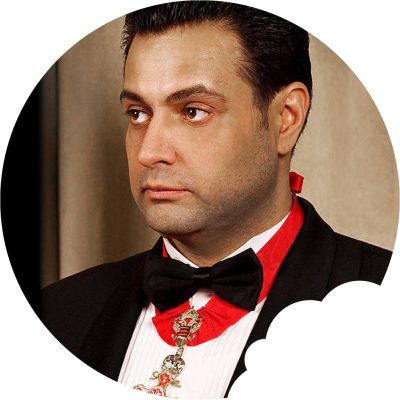
KRINGLE SALES WERE DOING WELL, SO THE PREMISES BUILT BY HANNES AND AILI BEGAN TO BECOME UNREASONABLY SMALL.
Kringle sales were doing well, so the premises build by Hannes and Aili began
to become unreasonably small. So Sami started looking for new premises in the
local area.
One of Sami's visions was to build a Kringles centre in Leppävirta alongside Highway 5, with a high-quality café-restaurant and the opportunity to watch the Kringle production. The project proved too expensive and the idea had to be abandoned. However, this did not discourage Sami - new ideas were constantly emerging.
One of Sami's visions was to build a Kringles centre in Leppävirta alongside Highway 5, with a high-quality café-restaurant and the opportunity to watch the Kringle production. The project proved too expensive and the idea had to be abandoned. However, this did not discourage Sami - new ideas were constantly emerging.
2001–2002

THE SEARCH FOR PREMISES CONTINUED. A SOLUTION WAS FINALLY FOUND 42 KILOMETRES AWAY IN SUONENJOKI.
The search for premises continued. A solution was finally found 42 kilometres
away in Suonenjoki. Negotiations with the decision-makers of the strawberry
city led to a pre-agreement, and the drafting of plans and drawings for the new
factory began. rt Michael was chosen as the architect of the modern factory
building located on Lintikonkatu. He also designed the modern Keski Café,
which opened in 2004 in the centre of Pieksämäki.
2003–2004
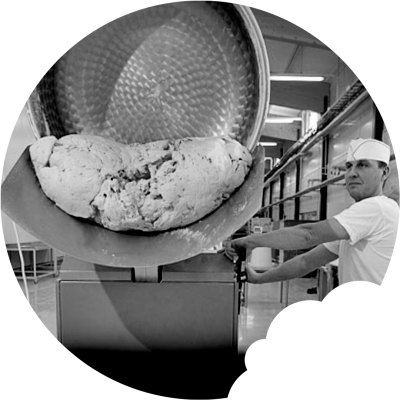
AN EFFICIENT INDUSTRIAL KRINGLE LINE TAILORED TO THE NEEDS OF KESKI WAS ACQUIRED FOR THE NEW FACTORY.
An efficient industrial Kringle line tailored to the needs of Keski was acquired
for the new factory. The technology was new, but the product quality was
based on unique recipes and manufacturing technology developed in
Pieksämäki. The production capacity of Kringles was quadrupled. Minister of
Trade and Industry Mauri Pekkarinen inaugurated the new premises in
December 2004.
2004
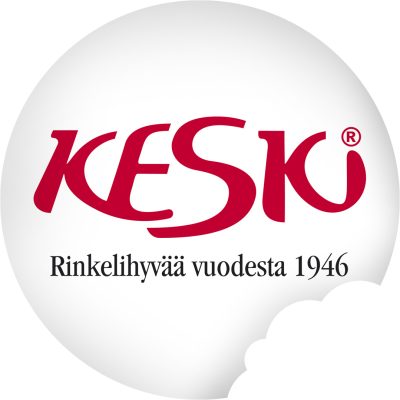
KESKI’S NEW LOOK DESIGNED FOR THE DOMESTIC MARKET WAS CREATED BY ADVERTISING AGENCY HERMO.
Keski's new look designed for the domestic market was created with
advertising agency Hermo. The brand represented dynamicness, flexibility and
capacity for reform. Keski now delivered Kringles from Utsjoki to Hanko and
from Uusikaupunki to Ilomantsi!
2008
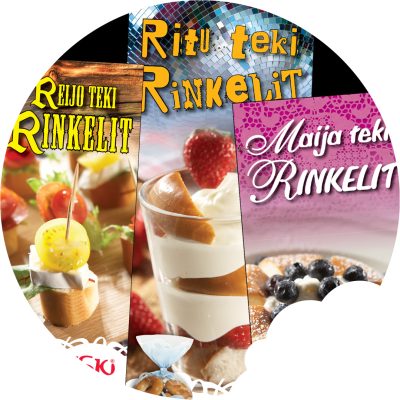
“MAKE KRINGLES”
“Make Kringles” was Keski's first nationally visible outdoor advertising
campaign. It introduced a wide range of uses and fillings for Kringles.
2009
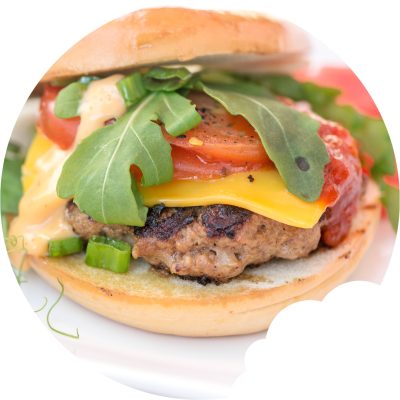
THE TRADITIONAL WATER-BASED KRINGLE WAS REINTRODUCED AS A COMPLETELY REDESIGNED KESKI KRINGLE.
The traditional water-based Kringle was reintroduced as a completed
redesigned Keski Kringle. A recipe bank was also opened on the website in
cooperation with the Hellapoliisi blog. Keski's self-control was expanded into a
food safety system in 2010-2011. As a result, Bureau Veritas awarded the
company an ISO 22000 quality certificate on October 31, 2011. In 2014, the
system was upgraded to meet FSSC 22000 requirements. At that time, the goal
of obtaining a quality certificate according to the BRC standard in 2020 was
also decided, which would make meeting customer requirements more visible
than before.
2010
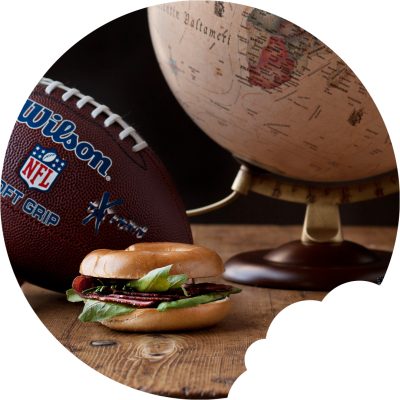
TO EXPAND THE RANGE, A COMPREHENSIVE SURVEY OF KRINGLE PRODUCTS WAS CARRIED OUT.
To expand the range, a comprehensive survey of Kringle products was
conducted in England, the United States and Sweden. Thus, frozen pre-split
Kringles were soon tested in the HORECA sector. As such, there was no demand
for Kringles in Finland, but once again Sami persistently continued to develop
his ideas. (As a result, the Toast Bagel was finally created in 2020).
2011
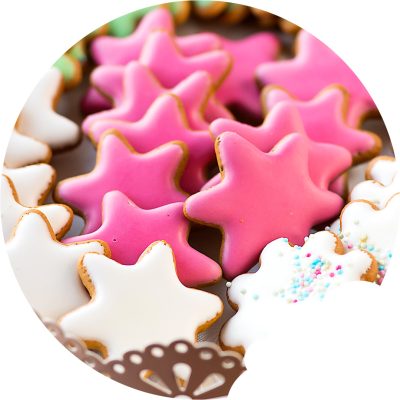
KESKI ENTERPRISE WAS ESTABLISHED IN TALLINN TO MANAGE AND LEAD THE TARGETED SIGNIFICANT GROWTH OF KESKI COMPANY.
Keski Enterprise was established in Tallinn to manage and lead the targeted
significant growth of the Keski Company. The aim was to expand the
manufacturing and product base through business acquisitions. Geographically,
the intention was to expand the sales area to the Baltics and Russia.
Initially, the product range was supplemented with delicious cookies and gingerbread biscuits, which were subcontracted from Parainen. The frosted gingerbread biscuits were baked using a recipe from a Swedish royal warrant of appointment. The new trading product categories (layer cakes, baked pies, frosted gingerbread biscuits and cheeses) aimed to increase turnover and profit.
Initially, the product range was supplemented with delicious cookies and gingerbread biscuits, which were subcontracted from Parainen. The frosted gingerbread biscuits were baked using a recipe from a Swedish royal warrant of appointment. The new trading product categories (layer cakes, baked pies, frosted gingerbread biscuits and cheeses) aimed to increase turnover and profit.
2013
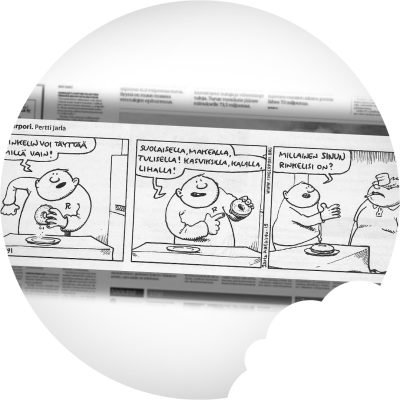
AS A RESULT OF LONG DEVELOPMENT WORK, A KESKI CARDAMOM-FLAVOURED KRINGLE WAS CREATED, WHICH IS SOFT AND DELICIOUS IN ITS OWN RIGHT AND HEAVENLY WHEN TUNED UP.
As a result of long development work, a Keski cardamom-flavoured Kringle was
created, which is soft and delicious in its own right and heavenly when tuned
up. This particular Kringle also makes the world’s best French toast. The “What
does your Kringle look like” campaign attracted widespread attention.
2014–2015
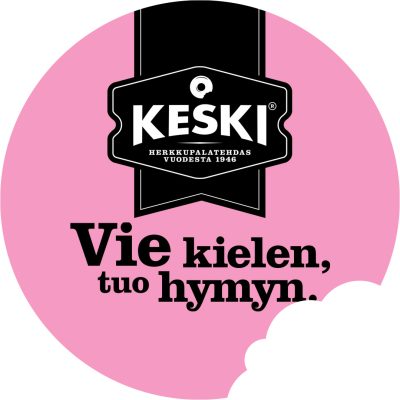
THE NEW BRAND OF THE KESKI TREAT FACTORY WAS CREATED TOGETHER WITH THE BANANA SPLIT CREATIVE TEAM.
The new brand of the Keski Treat Factory was created together with the Banana
Split Creative Team. In addition to Kringles, it was introduced in all new trading
product categories. At the same time, the sales organisation was strengthened
to increase Kringle sales, as well as to launch new product categories.
2015
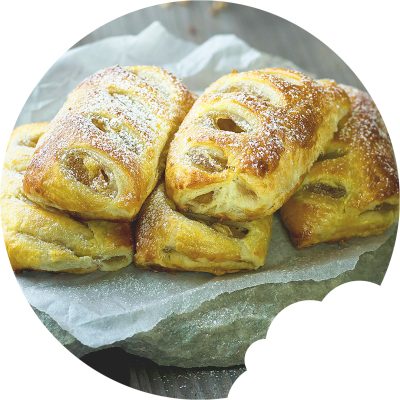
PROBLEMS AFTER PROBLEMS.
Problems after problems. The sales of intercompany products did not go as
planned. The Kringle sales performed by the new sales professionals also did
not live up to expectations, but instead sales in the product group fell by 35%!
The company was driven to the brink of bankruptcy.
The company was driven to the brink of bankruptcy.
2016
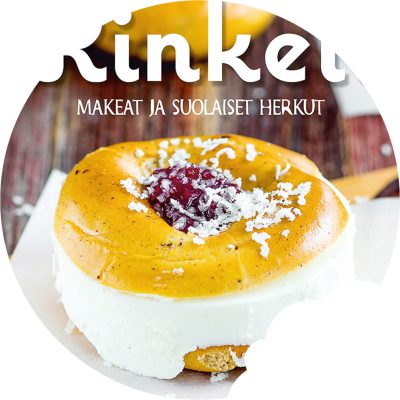
CHANGE IN DIRECTION.
Change in direction. Intercompany products were given up and focus was
moved back to Kringle production, sales and marketing. In other words, the
basics and doing them right. Top raw ingredients and the best proven
manufacturing technology is used in the production of Kringles. This ensures
the best product quality and customer satisfaction.
The book “Rinkeli – Makeat ja suolaiset rinkeliherkut” [Kringles- Sweet and savoury Kringle treats] was published together with Hellapoliisi Oy. The book is full of delicious recipes to make Kringles into sweet or savoury treats, as well as snacks.
The book “Rinkeli – Makeat ja suolaiset rinkeliherkut” [Kringles- Sweet and savoury Kringle treats] was published together with Hellapoliisi Oy. The book is full of delicious recipes to make Kringles into sweet or savoury treats, as well as snacks.
2017
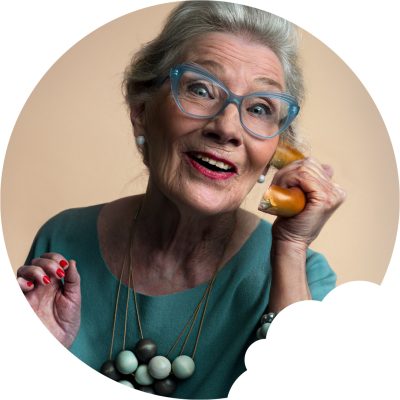
SYSTEMATIC AND LOGICAL ACTIVITIES.
Systematic and logical activities. Sales competitions aimed at merchants
continued. Individuals committed to the family business were also taken back
into the Kringle sales work positions. The outdoor advertising campaign “You
can play with Kringles” created a new, playful and fun image of the Kringle
product group.
The downfall in the Kringles trade was stopped at the last minute and the trade turned to growth. The Kringles' carbon footprint was also studied.
The downfall in the Kringles trade was stopped at the last minute and the trade turned to growth. The Kringles' carbon footprint was also studied.
2018
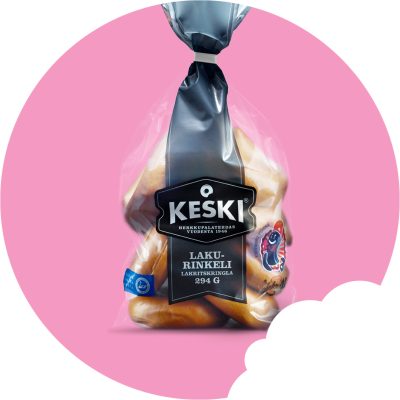
AN EVEN BRIGHTER VISION.
An even brighter vision. The focus was on clarifying the product portfolio of
Kringles, supporting sales through consulting activities, and repeating the
outdoor advertising campaign “You can play with Kringles”.
A new, interesting flavour, the Keski Liquorice Kringle was also launched at the Liquorice Festival at Wanha Satama in Helsinki.
In turn, the Keski Original Kringle was a transformation of the traditional version, with more than double the butter added to the dough according to the authentic traditional Keski recipe!
A new, interesting flavour, the Keski Liquorice Kringle was also launched at the Liquorice Festival at Wanha Satama in Helsinki.
In turn, the Keski Original Kringle was a transformation of the traditional version, with more than double the butter added to the dough according to the authentic traditional Keski recipe!
2019

ON MAY 10TH 1946, AILI AND HANNES HAARA FOUNDED A COMPANY CALLED PIEKSÄMÄEN KESKI.
On May 10, 1946, Aili and Hannes Haara founded a company called
Pieksämäen Keski. During the depression, together with all its shortages, it was
the most challenging time to start a bakery and confectionery business. Both
raw ingredients and machinery were subject to rationing. But Aili and Hannes
were determined to succeed. They combined Aili’s (b. Niemi) South
Ostrobothnia's entrepreneurship and dedication, as well as the experience and
expertise acquired by Hannes from Nilsiä as an Osuuskauppa baker and pastry
chef. Aili Haara also had previous entrepreneurial experience — she had
already set up a lucrative bakery-cafe at Närpiö station at the age of 18. She
understood what it means to be an entrepreneur in Finland. In the beginning
everything had to be done in the bakery by hand, and sometimes work was
done around the clock.
1946

THE NAME KESKI ALSO HAS A VERY LOGICAL BIRTH HISTORY.
The name KESKI also has a very logical birth history. The bakery started its
activities concretely and proudly in the middle of the commercial sector, hence
the name KESKI.
1946

DESPITE THE DIFFICULT TIMES, THE ENTERPRENEURIAL ACTIVITIES BORE FRUIT.
Despite the difficult times, the entrepreneurial activities bore fruit. Already
after a couple of years of operation, Keski expanded its sales area to various
parts of Finland.
Due to the rapid increase in demand, large ovens were needed that could bake all kinds of bakery products from morning to night. The furnaces at the time were heated with wood. The large incinerators were located downstairs and had to be heated at night so that the baking could start early in the morning. The actual baking ovens were located on the next floor.
A 50-seat restaurant with food and alcohol serving rights was also opened in 1948. Keski was classed as a 1st class restaurant according to the system used at the time. A sign indicating this was proudly visible on the outside wall of the restaurant. During the autumn of the same year, a clothing store, a separate children's department and a department of mixed goods, milk, bread and meat were opened. Yet Keski's pride was always the high-quality confectionery department. It can be said that the Keski commercial building was a small department store at that time.
Due to the rapid increase in demand, large ovens were needed that could bake all kinds of bakery products from morning to night. The furnaces at the time were heated with wood. The large incinerators were located downstairs and had to be heated at night so that the baking could start early in the morning. The actual baking ovens were located on the next floor.
A 50-seat restaurant with food and alcohol serving rights was also opened in 1948. Keski was classed as a 1st class restaurant according to the system used at the time. A sign indicating this was proudly visible on the outside wall of the restaurant. During the autumn of the same year, a clothing store, a separate children's department and a department of mixed goods, milk, bread and meat were opened. Yet Keski's pride was always the high-quality confectionery department. It can be said that the Keski commercial building was a small department store at that time.
1948

THE PRODUCTION OF CRACKER AND KRINGLE PRODUCTS BECAME MORE AND MORE EXTENSIVE.
The production of cracker and Kringle products became more and more
extensive. The bakery's machinery stock was renewed when, after three years
of waiting, an import licence was obtained to acquire a French bakery machine.
Due to rationing, bakeries only received permits to buy flour and syrup, so new
products had to be carefully planned. All this required great professionalism
and a lot of ingenuity.
The Finnish state also agreed to grant an import permit for the purchase of a modern Dutch biscuit machine. Its production capacity was up to 500 kg per hour! This is how Keski expanded its product range.
It was also the time of the Olympics buzz, when the most beautiful woman in the world came from Finland — and Coca-Cola came to Finland.
The Finnish state also agreed to grant an import permit for the purchase of a modern Dutch biscuit machine. Its production capacity was up to 500 kg per hour! This is how Keski expanded its product range.
It was also the time of the Olympics buzz, when the most beautiful woman in the world came from Finland — and Coca-Cola came to Finland.
1949-1952

DURING THE BUSY WORKING HOURS, THE STAFF ALWAYS HAD TIME TO POSE TOGETHER.
During the busy working hours, the staff always had time to pose together. It’s
easy to smile, when the mind feels good and a growing company creates
security for the future.
1954

KESKI WAS VISIBLE AND HEARD IN THE STREET PICTURE OF PIEKSÄMÄKI.
Keski was visible and heard in the street image of Pieksämäki. Every year at
the beginning of October, the fashion shows starring Finland's most famous
mannequins gathered a crowd of people in front of Keski's shop windows.
In the showcase competitions organized by the Pieksämäki Entrepreneurs' Association, Keski enjoyed the popularity of the public and received the first prizes — several years in a row. The daughter of the family, Leena, contributed with special merit to the design and decoration of the victorious shop windows.
In the showcase competitions organized by the Pieksämäki Entrepreneurs' Association, Keski enjoyed the popularity of the public and received the first prizes — several years in a row. The daughter of the family, Leena, contributed with special merit to the design and decoration of the victorious shop windows.
1955

OPERATIONS CONTINUED TO EXPAND AS DEMAND FOR BAKERY PRODUCTS INCREASED.
Operations continued to expand as demand for bakery products increased.
More space was needed. Aili and Hannes Haara decided to implement an
additional building, for which they had received a building permit after some
challenging steps.
The manufacture of crackers and Kringles was moved to this additional building. A Werner & Pfleiderer dough machine and rotary kiln were acquired from Germany, of which only a few existed in Finland before Keski's investments. Two cracker-forming machines were also acquired from the Soviet Union at the same time, but they never worked. The baking of crackers continued to be done by hand.
The manufacture of crackers and Kringles was moved to this additional building. A Werner & Pfleiderer dough machine and rotary kiln were acquired from Germany, of which only a few existed in Finland before Keski's investments. Two cracker-forming machines were also acquired from the Soviet Union at the same time, but they never worked. The baking of crackers continued to be done by hand.
1957

A NEW ROTARY KILN IN ACTION!
A new rotary kiln in action! The capacity of the factory was raised to a new
level. Keski was able to expand its sales and distribution area to cover the
whole of Finland. The first colour photograph taken at the factory also evokes
fascination.
1959

THE WORK DONE AT KESKI WAS ALSO NOTED AT A STATE LEVEL.
The work done at Keski was also noted at a state level. On 1st December 1967,
the President of the Republic Urho Kekkonen awarded CEO Hannes Haara the
honorary title of Talousneuvos for his contributions to the welfare and active
development of the province's economic life.
1967

ALTHOUGH DAUGHTERS LEENA AND KATARIINA WERE STILL PUPILS AND STUDENTS, THEY ARE ACTIVELY INVOLVED IN THE ACTIVITIES OF THE FAMILY BUSINESS.
Although daughters Leena and Katariina were still pupils and students, they are
actively involved in the activities of the family business — including the
creating ideas for new products. The photo is from the Frankfurt Bakery Fair.
1968

THE FAMOUS SUMMER OF FLOWERS.
The famous summer of flowers - the Summer of '69 - that is also referred to in
songs. During the summer season, more Kringles were exported around the
world in a day than there were hippies at Woodstock.
1969

BLACK CARS TOOK OVER THE STREET VIEW OF PIEKSÄMÄKI.
Black cars took over the street view of Pieksämäki on the day of the funeral of
a prominent figure in March 1970. After the death of Hannes Haara,
responsibility for the company passed to Aili Haara. Over the years they had
together created a successful family business. Hard-working and diligent Aili
continued to lead and develop the company with determination.
1970

AILI AND HANNES HAARA'S GRANDSON SAMI HAARA CELEBRATES HIS 3RD BIRTHDAY WITH HIS MOTHER KATARINA AND FATHER FAROG.
Aili and Hannes Haara's grandson Sami Haara celebrates his 3rd birthday with
his mother Katarina and father Farog. At this point, Sami could hardly have
foreseen that he would one day be an entrepreneur and “Kringle Emperor”.
However, the servings were already fabulously delicious!
1979

AILI HAARA WAS VERY PRO-REFORM IN EVERYTHING AND IN MANY RESPECTS AHEAD OF HER TIME.
Aili Haara was very pro-reform in everything and in many ways ahead of her
time. After one reform was done, she already began to plan the next one. For
example, she acquired three large automatic flour silos for the factory, which
significantly increased the efficiency of work in the bakery.
Keski’s delegation also visited Italy to get acquainted with their Kringle machines, their operation and the Kringle lifting lines. The machines were found to be highly functional, so it was decided to make a significant investment by acquiring an automated Kringle making line. Operational reliability, product quality and production capacity took a giant leap!
Keski’s delegation also visited Italy to get acquainted with their Kringle machines, their operation and the Kringle lifting lines. The machines were found to be highly functional, so it was decided to make a significant investment by acquiring an automated Kringle making line. Operational reliability, product quality and production capacity took a giant leap!
EARLY 1980s

AILI HAARA RECEIVED THE RECOGNITION SHE DESERVES.
Aili Haara received the recognition she deserved. She was awarded the
Pieksämäki Entrepreneur of the Year Award in 1986. In her thank-you speech,
Aili thanked the competent and loyal staff and particularly emphasised the
importance of product quality to Keski's 40-year success story.
And that's not all, there was more to come. Aili was also awarded Pieksämäki Resident of the Year in the same year — and she also received the prestigious Provincial Entrepreneur of the Year award.
And that's not all, there was more to come. Aili was also awarded Pieksämäki Resident of the Year in the same year — and she also received the prestigious Provincial Entrepreneur of the Year award.
1986

AILI WAS THE DETERMINED AND CHARISMATIC MATRIARCH OF THE HAARA FAMILY.
Aili was the determined and charismatic matriarch of the Haara family. A direct
and honest Ostrobothnian and self-respecting business manager and owner.
Therefore, as an accomplished businesswoman, she also amassed considerable
wealth.
1987–1990

IT WAS DECIDED TO EXPERIMENT IF THE GRASS WOULD BE GREENER ON THE WEST SIDE OF THE BAY.
It was decided to experiment if the grass would be greener on the west side of
the bay. In other words, the sale of Kringles to Sweden, in the Gothenburg and
Stockholm regions, was started in 1991. In the following years, export efforts to
Russia also paid off, as Keski Kringles were included in the assortment of the St.
Petersburg Siwa chain.
1991

SAD NEWS.
Sad news. In June 1992, entrepreneur Aili Haara passed away after running the
company for more than two decades following Hannes' death. After Aili's death,
responsibility for the company passed to her children, Heikki and Katariina.
Leena had already established her own art design company in Helsinki.
1992

ENTREPRENEURSHIP SHOWS THE SIBLINGS IN THEIR FIRST YEARS ALL ITS MOST CHALLENGING ASPECTS.
Entrepreneurship shows the siblings in their first years all its most challenging
aspects. It was a time of recession, which was, however, overcome. After that,
Heikki and Katariina's major differences in views on the management and
development of the company came into the picture. They were reflected in the
company's turnover and earnings, which plummeted. Keski's economic
situation began to be worrying.
1993–1996

KATARIINA ENTERED INTO NEGOTIATIONS TO BUY THE SHARES OF THE ALMOST-BANKRUPT COMPANY FROM HER BROTHER HEIKKI.
Katariina began negotiations to buy the shares of the almost-bankrupt
company from her brother Heikki. A deal was reached in the end. As a result of
the transaction, Katariina was the sole owner of the entire company. At the
same time, she decided to give up on the clothing sales. Keski's activities again
focused on the manufacture of Kringles, their nationwide sales and marketing.
The business was made profitable, revenue increased and profit improved.
1997–1998

THE HAARA FAMILY AND KESKI FACE TRAGIC TIMES AGAIN.
The Haara family and Keski face tragic times again. Katariina's husband Farog
dies of a heart attack, and only four months later, Katariina herself passes
away exhausted by a severe illness. Responsibility for the company is passed
to their son, Sami Haara, aged just 23.
1999

THE BEGINNING OF THE MILLENNIUM WAS A TIME OF LEARNING FOR THE YOUNG ENTREPRENEUR AND HIS COLOURFUL PERSONALITY.
The beginning of the millennium was a time of learning for the young
entrepreneur and his colourful personality. But Sami was quick-witted,
business-spirited and marketing-oriented. When he had a good idea, he worked
for it courageously and tirelessly. To the surprise of many, the business quickly
took off on a new upswing.
EARLY 2000s

KRINGLE SALES WERE DOING WELL, SO THE PREMISES BUILT BY HANNES AND AILI BEGAN TO BECOME UNREASONABLY SMALL.
Kringle sales were doing well, so the premises build by Hannes and Aili began
to become unreasonably small. So Sami started looking for new premises in the
local area.
One of Sami's visions was to build a Kringles centre in Leppävirta alongside Highway 5, with a high-quality café-restaurant and the opportunity to watch the Kringle production. The project proved too expensive and the idea had to be abandoned. However, this did not discourage Sami - new ideas were constantly emerging.
One of Sami's visions was to build a Kringles centre in Leppävirta alongside Highway 5, with a high-quality café-restaurant and the opportunity to watch the Kringle production. The project proved too expensive and the idea had to be abandoned. However, this did not discourage Sami - new ideas were constantly emerging.
2001–2002

THE SEARCH FOR PREMISES CONTINUED. A SOLUTION WAS FINALLY FOUND 42 KILOMETRES AWAY IN SUONENJOKI.
The search for premises continued. A solution was finally found 42 kilometres
away in Suonenjoki. Negotiations with the decision-makers of the strawberry
city led to a pre-agreement, and the drafting of plans and drawings for the new
factory began. rt Michael was chosen as the architect of the modern factory
building located on Lintikonkatu. He also designed the modern Keski Café,
which opened in 2004 in the centre of Pieksämäki.
2003–2004

AN EFFICIENT INDUSTRIAL KRINGLE LINE TAILORED TO THE NEEDS OF KESKI WAS ACQUIRED FOR THE NEW FACTORY.
An efficient industrial Kringle line tailored to the needs of Keski was acquired
for the new factory. The technology was new, but the product quality was
based on unique recipes and manufacturing technology developed in
Pieksämäki. The production capacity of Kringles was quadrupled. Minister of
Trade and Industry Mauri Pekkarinen inaugurated the new premises in
December 2004.
2004

KESKI’S NEW LOOK DESIGNED FOR THE DOMESTIC MARKET WAS CREATED BY ADVERTISING AGENCY HERMO.
Keski's new look designed for the domestic market was created with
advertising agency Hermo. The brand represented dynamicness, flexibility and
capacity for reform. Keski now delivered Kringles from Utsjoki to Hanko and
from Uusikaupunki to Ilomantsi!
2008

“MAKE KRINGLES”
“Make Kringles” was Keski's first nationally visible outdoor advertising
campaign. It introduced a wide range of uses and fillings for Kringles.
2009

THE TRADITIONAL WATER-BASED KRINGLE WAS REINTRODUCED AS A COMPLETELY REDESIGNED KESKI KRINGLE.
The traditional water-based Kringle was reintroduced as a completed
redesigned Keski Kringle. A recipe bank was also opened on the website in
cooperation with the Hellapoliisi blog. Keski's self-control was expanded into a
food safety system in 2010-2011. As a result, Bureau Veritas awarded the
company an ISO 22000 quality certificate on October 31, 2011. In 2014, the
system was upgraded to meet FSSC 22000 requirements. At that time, the goal
of obtaining a quality certificate according to the BRC standard in 2020 was
also decided, which would make meeting customer requirements more visible
than before.
2010

TO EXPAND THE RANGE, A COMPREHENSIVE SURVEY OF KRINGLE PRODUCTS WAS CARRIED OUT.
To expand the range, a comprehensive survey of Kringle products was
conducted in England, the United States and Sweden. Thus, frozen pre-split
Kringles were soon tested in the HORECA sector. As such, there was no demand
for Kringles in Finland, but once again Sami persistently continued to develop
his ideas. (As a result, the Toast Bagel was finally created in 2020).
2011

KESKI ENTERPRISE WAS ESTABLISHED IN TALLINN TO MANAGE AND LEAD THE TARGETED SIGNIFICANT GROWTH OF KESKI COMPANY.
Keski Enterprise was established in Tallinn to manage and lead the targeted
significant growth of the Keski Company. The aim was to expand the
manufacturing and product base through business acquisitions. Geographically,
the intention was to expand the sales area to the Baltics and Russia.
Initially, the product range was supplemented with delicious cookies and gingerbread biscuits, which were subcontracted from Parainen. The frosted gingerbread biscuits were baked using a recipe from a Swedish royal warrant of appointment. The new trading product categories (layer cakes, baked pies, frosted gingerbread biscuits and cheeses) aimed to increase turnover and profit.
Initially, the product range was supplemented with delicious cookies and gingerbread biscuits, which were subcontracted from Parainen. The frosted gingerbread biscuits were baked using a recipe from a Swedish royal warrant of appointment. The new trading product categories (layer cakes, baked pies, frosted gingerbread biscuits and cheeses) aimed to increase turnover and profit.
2013

AS A RESULT OF LONG DEVELOPMENT WORK, A KESKI CARDAMOM-FLAVOURED KRINGLE WAS CREATED, WHICH IS SOFT AND DELICIOUS IN ITS OWN RIGHT AND HEAVENLY WHEN TUNED UP.
As a result of long development work, a Keski cardamom-flavoured Kringle was
created, which is soft and delicious in its own right and heavenly when tuned
up. This particular Kringle also makes the world’s best French toast. The “What
does your Kringle look like” campaign attracted widespread attention.
2014–2015

THE NEW BRAND OF THE KESKI TREAT FACTORY WAS CREATED TOGETHER WITH THE BANANA SPLIT CREATIVE TEAM.
The new brand of the Keski Treat Factory was created together with the Banana
Split Creative Team. In addition to Kringles, it was introduced in all new trading
product categories. At the same time, the sales organisation was strengthened
to increase Kringle sales, as well as to launch new product categories.
2015

PROBLEMS AFTER PROBLEMS.
Problems after problems. The sales of intercompany products did not go as
planned. The Kringle sales performed by the new sales professionals also did
not live up to expectations, but instead sales in the product group fell by 35%!
The company was driven to the brink of bankruptcy.
The company was driven to the brink of bankruptcy.
2016

CHANGE IN DIRECTION.
Change in direction. Intercompany products were given up and focus was
moved back to Kringle production, sales and marketing. In other words, the
basics and doing them right. Top raw ingredients and the best proven
manufacturing technology is used in the production of Kringles. This ensures
the best product quality and customer satisfaction.
The book “Rinkeli – Makeat ja suolaiset rinkeliherkut” [Kringles- Sweet and savoury Kringle treats] was published together with Hellapoliisi Oy. The book is full of delicious recipes to make Kringles into sweet or savoury treats, as well as snacks.
The book “Rinkeli – Makeat ja suolaiset rinkeliherkut” [Kringles- Sweet and savoury Kringle treats] was published together with Hellapoliisi Oy. The book is full of delicious recipes to make Kringles into sweet or savoury treats, as well as snacks.
2017

SYSTEMATIC AND LOGICAL ACTIVITIES.
Systematic and logical activities. Sales competitions aimed at merchants
continued. Individuals committed to the family business were also taken back
into the Kringle sales work positions. The outdoor advertising campaign “You
can play with Kringles” created a new, playful and fun image of the Kringle
product group.
The downfall in the Kringles trade was stopped at the last minute and the trade turned to growth. The Kringles' carbon footprint was also studied.
The downfall in the Kringles trade was stopped at the last minute and the trade turned to growth. The Kringles' carbon footprint was also studied.
2018

AN EVEN BRIGHTER VISION.
An even brighter vision. The focus was on clarifying the product portfolio of
Kringles, supporting sales through consulting activities, and repeating the
outdoor advertising campaign “You can play with Kringles”.
A new, interesting flavour, the Keski Liquorice Kringle was also launched at the Liquorice Festival at Wanha Satama in Helsinki.
In turn, the Keski Original Kringle was a transformation of the traditional version, with more than double the butter added to the dough according to the authentic traditional Keski recipe!
A new, interesting flavour, the Keski Liquorice Kringle was also launched at the Liquorice Festival at Wanha Satama in Helsinki.
In turn, the Keski Original Kringle was a transformation of the traditional version, with more than double the butter added to the dough according to the authentic traditional Keski recipe!
2019
